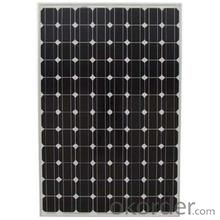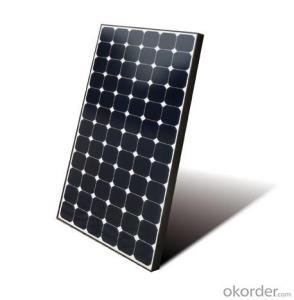CNBM On Grid System 900W with Certificate UL TUV CE
- Loading Port:
- Shanghai
- Payment Terms:
- TT OR LC
- Min Order Qty:
- 100 watt
- Supply Capability:
- 1000 watt/month
OKorder Service Pledge
OKorder Financial Service
You Might Also Like
Item specifice
CNBM On Grid System 900W with Certificate UL TUV CE
Product description
A grid-connected photovoltaic power system, or grid-connected PV system is anelectricity generating solar PV system that is connected to the utility grid. A grid-connected PV system consists of solar panels, one or several inverters, a power conditioning unit and grid connection equipment. They range from small residential and commercial rooftop systems to large utility-scale solar power stations. Unlike stand-alone power systems, a grid-connected system rarely includes an integrated battery solution, as they are still very expensive. When conditions are right, the grid-connected PV system supplies the excess power, beyond consumption by the connected load, to the utility grid.
Connection of the photovoltaic power system can be done only through an interconnection agreement between the consumer and the utility company. The agreement details the various safety standards to be followed during the connection.[4]
Grid-connected PV can cause issues with voltage regulation. The traditional grid operates under the assumption of one-way, or radial, flow. But electricity injected into the grid increases voltage, and can drive levels outside the acceptable bandwidth of ±5%.[8]

Application
Industrial
Commercial
Residential
Feature
Residential, grid-connected rooftop systems which have a capacity more than 10 kilowatts can meet the load of most consumers.[2] They can feed excess power to the grid where it is consumed by other users. The feedback is done through a meter to monitor power transferred. Photovoltaic wattage may be less than average consumption, in which case the consumer will continue to purchase grid energy, but a lesser amount than previously. If photovoltaic wattage substantially exceeds average consumption, the energy produced by the panels will be much in excess of the demand. In this case, the excess power can yield revenue by selling it to the grid. Depending on their agreement with their local grid energy company, the consumer only needs to pay the cost of electricity consumed less the value of electricity generated. This will be a negative number if more electricity is generated than consumed.[3] Additionally, in some cases, cash incentives are paid from the grid operator to the consumer.
Packaging
With carton and box
- Q:Can solar energy systems be used for powering remote communication towers?
- Yes, solar energy systems can be used for powering remote communication towers. Solar panels can generate electricity from sunlight, which can then be stored in batteries for use during times when sunlight is not available. This makes solar energy a reliable and sustainable option for powering remote communication towers, especially in areas where grid electricity is unavailable or unreliable.
- Q:Can solar energy systems be used for powering off-grid disaster response teams?
- Yes, solar energy systems can certainly be used for powering off-grid disaster response teams. Solar energy systems, such as photovoltaic panels or solar generators, can provide a reliable and sustainable source of power in remote or disaster-stricken areas where traditional power sources may be unavailable or disrupted. These systems can be easily deployed and are capable of charging communication devices, medical equipment, lighting, and other essential tools required by disaster response teams. Additionally, solar energy systems can reduce dependency on fossil fuels and contribute to a more environmentally friendly response to disasters.
- Q:Can a solar energy system be installed in an area with a high lightning risk?
- Yes, a solar energy system can be installed in an area with a high lightning risk. However, additional precautions and safety measures must be taken during the installation process to protect the system from potential lightning strikes. This may include installing lightning protection systems, grounding equipment, and surge protectors to minimize the risk of damage.
- Q:How do solar energy systems impact the demand for fossil fuels?
- Solar energy systems can have a significant impact on the demand for fossil fuels. By harnessing energy from the sun, solar systems reduce the need for traditional fossil fuel-based electricity generation. This decrease in demand for fossil fuels helps to alleviate the environmental impact associated with their extraction, combustion, and greenhouse gas emissions. Additionally, the widespread adoption of solar energy systems can promote energy independence and reduce reliance on fossil fuel imports, leading to a more sustainable and resilient energy future.
- Q:Can solar energy systems be used for powering off-grid sustainable communities?
- Yes, solar energy systems can be used to power off-grid sustainable communities. Solar panels can generate electricity from the sun's rays, providing a reliable and renewable energy source. This can be harnessed to power various appliances, lighting, heating, and cooling systems in off-grid communities. By utilizing solar energy, these communities can reduce their dependence on fossil fuels and contribute to a more sustainable and environmentally friendly lifestyle.
- Q:What is the impact of roof age on the performance of solar panels?
- Solar panel performance can be significantly influenced by the age of the roof. Generally, a newer roof is more structurally sound and better able to handle the weight of the panels. Additionally, it is less likely to have any preexisting issues like leaks or damage that could interfere with installation and performance. Conversely, an older roof may have deteriorated over time, potentially resulting in structural problems or leaks. This can pose challenges and incur additional costs during installation, as the roof may require repairs or reinforcement prior to panel installation. Moreover, an older roof may not be as energy-efficient as a newer one, which can impact the overall performance of the solar panels. The insulation and ventilation systems of an older roof may not function as effectively, leading to increased heat transfer or inadequate air circulation, thereby reducing panel efficiency. Assessing the roof's condition before installing solar panels is crucial to ensure optimal performance and longevity. If the roof is in poor condition, it may be necessary to repair or replace it before proceeding with installation. In conclusion, the age and condition of the roof significantly affect the performance and efficiency of solar panels.
- Q:Are solar panels weather-resistant?
- Yes, solar panels are weather-resistant. They are designed to withstand various weather conditions, including rain, snow, hail, and high winds. The materials used in solar panels are durable and can withstand exposure to different climates and temperatures. However, extreme weather events like hurricanes and tornadoes can potentially damage solar panels, although this is relatively rare.
- Q:What is the impact of roof angle on the performance of solar panels?
- The angle of a roof has a significant impact on the performance of solar panels. The ideal roof angle depends on the geographical location of the installation and the time of year. In general, solar panels perform best when they are tilted at an angle that allows them to capture the maximum amount of sunlight throughout the day. This is because the angle affects the amount of direct sunlight that falls on the panels, which directly impacts their energy production. In regions closer to the equator, where the sun is more directly overhead, a roof angle of around 30 to 45 degrees is typically recommended. This allows the panels to receive the maximum amount of sunlight during the year. On the other hand, in regions farther from the equator, where the sun is lower in the sky, a steeper roof angle of around 45 to 60 degrees may be more suitable to optimize solar panel performance. The impact of the roof angle on solar panel performance is also noticeable during different seasons. For example, in the summer when the sun is higher in the sky, a flatter roof angle may be more effective in capturing sunlight. Conversely, during the winter when the sun is lower, a steeper roof angle can help maximize energy production. It is important to note that while the roof angle is a crucial factor, other factors such as the orientation of the panels (facing south is usually preferred in the Northern Hemisphere) and shading from nearby objects or trees can also influence the performance of solar panels. Proper planning and design are essential to ensure optimal performance and efficiency of the solar panel system.
- Q:Can solar energy systems be used for electric vehicle charging stations?
- Yes, solar energy systems can be used for electric vehicle charging stations. Solar panels can generate electricity that can be used to charge electric vehicles, making them a sustainable and environmentally-friendly option for powering EV charging stations.
- Q:Can solar energy systems be used in areas with low sunlight?
- Yes, solar energy systems can still be used in areas with low sunlight. While solar panels are most effective in areas with abundant sunlight, advancements in solar technology have made it possible to generate electricity even in areas with lower sunlight levels. Additionally, solar energy systems can still provide a reliable source of energy in such areas by utilizing battery storage to store excess energy generated during periods of higher sunlight and using it during times of lower sunlight.
1. Manufacturer Overview |
|
|---|---|
| Location | |
| Year Established | |
| Annual Output Value | |
| Main Markets | |
| Company Certifications | |
2. Manufacturer Certificates |
|
|---|---|
| a) Certification Name | |
| Range | |
| Reference | |
| Validity Period | |
3. Manufacturer Capability |
|
|---|---|
| a)Trade Capacity | |
| Nearest Port | |
| Export Percentage | |
| No.of Employees in Trade Department | |
| Language Spoken: | |
| b)Factory Information | |
| Factory Size: | |
| No. of Production Lines | |
| Contract Manufacturing | |
| Product Price Range | |
Send your message to us
CNBM On Grid System 900W with Certificate UL TUV CE
- Loading Port:
- Shanghai
- Payment Terms:
- TT OR LC
- Min Order Qty:
- 100 watt
- Supply Capability:
- 1000 watt/month
OKorder Service Pledge
OKorder Financial Service
Similar products
New products
Hot products
Related keywords





























